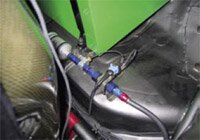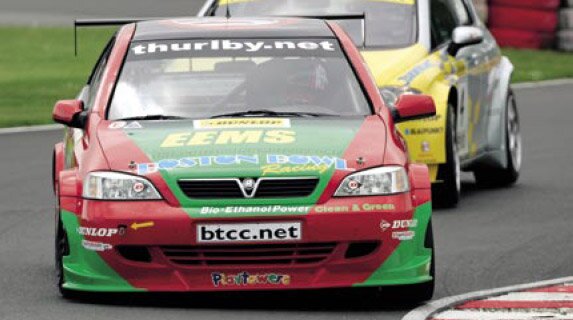
Articles
 Environmental news Environmental news |
 |
|
 Motorsport Development UK Motorsport Development UK |
 |
|
 Motorsport industry Motorsport industry |
 |
|
 Motorsport technology Motorsport technology |
 |
|
 Sporting regulations and results Sporting regulations and results |
 |
|
Complete Control
Author: Charles Armstrong-Wilson
Source: Racecar Engineering
Publication Date: 1st July 2006
How can you make motorsport relevant in this energy conscious age? That is the challenge facing Energy Efficient Motorsport (EEMS), a body sponsored by the government. Right from its beginnings, motorsport was always about extremes and excess. The challenge has been how to go faster than anyone else and for longer; it was a mandate for conspicuous consumption.
Over the decades, obstacles have been placed in the path of engineers to slow cars down. Restrictions have usually come in the form of engine capacity limits, but more recently air restrictors, mandated production engines and, most recently controlled or ‘crate’ engines. But none of these initiatives have been focused on promoting efficiency. That is not to say they haven’t achieved that goal unintentionally. Clever engine builders and teams have realized the advantages of efficient use of energy. Efficient burn produces more power. Also efficient use of fuel can mean a smaller weight burden giving better performance or fewer time-consuming refuelling stops in a race. At an engineering conference a couple of years ago, Ferrari’s Ross Brawn commented that he felt many Formula 1 teams had been slow to wake up to the benefits of good economy over outright power, intimating that it was a quality his team had been exploiting to good effect.
It seemed, then, that fuel effi ciency was an accidental by-product of motorsport regulations, rather than an intention. Also, the rules generally did nothing to promote the use of alternative fuels and thereby encouraging research and development into them. The message was clear that from an environmental perspective, motorsport could be used much more efficiently as a technical resource and the sport would benefit from an improved public image.
Tackling this was a clear target for EEMS with its brief to encourage the development of alternative fuels and powertrain technologies and promote energy efficiency at the heart of modern motorsport. The organisation’s Dr Steve Bunkhall said, ‘The EEMS vision is to apply the extraordinary skills and capability of UK motorsport to developing environmentally friendly technologies; at the same time reducing the environmental impact of motorsport itself. Environmental pressures are already changing the automotive world. We see an opportunity for UK motorsport to lead the way to a greener future by showcasing more energy efficient racing that is still exciting to watch and participate in.’
EEMS is one of five programmes sponsored by Motorsport Development UK, whose mission is to sustain and develop the UK’s motorsport sector. Funding for the programme comes directly from the government’s Department of Trade and Industry and four regional development agencies.


At the heart of the system is this flow sensing valve that allows accurate measurement of the rate at which fuel is being delivered to the engine
In the past it has been involved in several alternative fuel initiatives including the Nasamax bioenthanol-fuelled LMP1 that ran at Le Mans in 2003–2004 and a liquid petroleum gas-powered car in the 2004 British Touring Car Championship. However, those behind the initiative wanted to develop more universal strategies applicable to a broad range of motorsport, encouraging alternative fuels and energy efficiency research. As Bunkhall puts it, ‘how do we put a premium on fuel efficiency?’ It was not going to be easy. ‘Nobody is going to go for something that won’t give exciting motorsport,’ warns Bunkhall. So anything that smacked of an economy marathon was an instant non-starter. That quickly killed ideas of limited fuel capacity and no refueling. Once hard racing got everyone down to the minimum needed to finish the event, it would be a procession to the flag with those who had overcooked it running out. Not a great show.
Other ideas were considered including flow restrictors or carefully calibrated fuel injectors. Eventually the problem was given to respected industry consultant Ricardo to look at, where a team of engineers examined the options. A simple flow restrictor was seen as problematic. Apart from the difficulty of ensuring accuracy and consistency across a batch, it was felt that teams’ efforts to improve flow would cause problems. Obviously they would be looking to lower the temperature and increase the pressure to force as much mass through the hole as possible. At the limit this would create cavitation and bubbles of fuel vapour; not good for an injection system. Calibrating injectors also promised to be acomplicated process. Either a vast range of injectors would have to be calibrated and policed to cover all the options on the grid, or one type of injector would have to be mandated which everyone felt would restrict development. Also to log the volume and duration of the injector pulses in a high revving race engine would take a very high frequency logger.
The recommendation came back that a method of monitoring fuel flow should be used. This is not a restrictor, rather it contains an impeller and a Hall Effect sensor to accurately measure the fuel flow. The unit the company recommended is manufactured by Pi Research and is normally used for monitoring process streams in the chemical industry. It has also seen some use in motorsport including NASCAR where it has been applied to analyzing fuel flow in testing.
Readings from the valve can be logged on a scrutineer’s on-board data acquisition system and the fuel flow scrutinized after the race to ensure it never exceeds the stated maximum permitted flow. How the teams keep within the limit would be up to them. A feed from the unit would be accessible to the teams during the race and could be used to restrict the engine’s consumption by controlling revs or prompting the driver to make an upchange before the fuel flow exceeds the maximum.
Most importantly it would allow different fuels to be used alongside each other in different cars with a direct equivalency factor. Rather than trying to balance engine capacities, turbo boost or restrictor sizes to establish a level playing field, it can be done directly with reference to the fuel. The different calorific values of the fuels can be used to calculate a flow rate that gives the same amount of energy over time.
All this sounds great in theory, but convincing championship regulators that it can work in practice is another matter. To gain credibility, EEMS needs to demonstrate the accuracy and reliability of the technology in a racing environment so it has turned to the British Touring Car Championship. Currently there is no prospect of the BTCC adopting a fuel-flow formula as organizing body TOCA is already committed to Super 2000 regulations for 2007. However, as a leading national series it offered the right environment to test the technology and the organizers were willing to allow the valves to be fitted to cars in the series provided they didn’t interfere with performance and the racing. Peter Riches, rule maker for the series says, ‘I believe that adopting alternative fuels is a culture issue. You have to create the circumstances for teams to take that route. We have a flexible approach to the rule book and are open to suggestions to make alternative fuel cars competitive.’

The Techspeed Vauxhall Astra began running with the EEMS fuel valve in the BTCC last year. This season EEMS is offering the unit free to all BTCC teams
During the 2005 season, EEMS arranged to fit one of the valves to the Techspeed Vauxhall Astra driven by Fiona Leggate. This not only demonstrated the unit’s reliability but also showed the kind of information the unit was able to give the team. With the accuracy of this information, more so than just counting the injector pulses, engineers were able to take a closer look at energy consumption.
Now EEMS has offered the same fuel metering technology to all the teams for free. So far the response has been typically motorsport; in other words, cautious. However, there has been interest and EEMS believes there are things that will persuade the teams to adopt the valves in the long term. Firstly, the prospect of them one day becoming compulsory means that it is worth becoming familiar with the technology. Secondly, the extra information on the car’s fuel consumption could be exploited to the team’s advantage. The hope is that is if all the teams adopt the fuel flow valve and they become comfortable with the technology, then it is a simple step to using it as a means of controlling performance at some point in the future.
Practical experience also helps EEMS learn how to make the system workable. Any racer faced with this as a means of performance restriction would immediately start looking for ways to ‘optimise’ it. So any schemes that might circumvent the system have to be anticipated. For example it would be a benefit to pool fuel downstream of the unit during periods of low consumption, like under braking, to be used at moments of high demand. Also, temperature affects the volume of fuel for a given quantity of energy so the fuel temperature is also measured.
The valve works best with returnless injection systems, as measuring both the supply and the return introduces unacceptable errors. However, with a returnless system a reservoir downstream of the sensor is necessary to ensure supply to the injectors at all times. To avoid using this to gain a performance advantage, it would have to be as small as possible and rigid with no potential for building a pool of fuel.
The project was started two years ago and still has a long way to go but Ricardo is still involved and now plans to develop a strategy for controlling fuel flow within a pre-set limit using the ECU. For now, it offers a tantalizing glimpse of a new way of restricting racecars.
Added to the database on 16th October 2006
These articles are also recommended
- Fuel for Thought
- Home Grown Power
Keywords: efficiency, eems, btcc, techspeed astra, fiona leggate, fuel efficiency, motorsport, touring cars, environment
